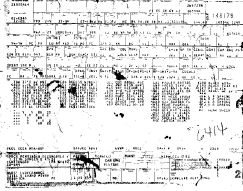Build Sheet Bingo explains and illustrates everything that we have listed on our 1976-81 Firebird build sheets. If you want to read more about where the data came from, scroll on down. If not,
Click on the build sheet to play Build Sheet Bingo!

What's a Build Sheet?
The build sheet or broadcast sheet is a recipe used on the assembly line to build each car. As the car came down the line, workers put components on it according to what was on the sheet. At a bare minimum, the sheet had to show all the pay-extra options and the color and size of every everthing that comes in more than one color or size.
Generally speaking, build sheets are very important in establishing the originality of old cars. This becomes pretty important when documenting the original configuration of a car makes a huge difference in its value.
However, Pontiac owners are uniquely blessed to have a separate source of information that's just about as good. Years ago, the Pontiac billing records were provided to Jim Matteson and he established Pontiac Historical Services to, for a fee, document your Pontiac's original equipment. You can find more about that at PHS online. Owners of other kinds of cars do not have this advantage, and their genuine cars are suffocating under a pile of fake Shelby's, Z28's, etc. Thanks to PHS, you'll never have to believe any stupid story about how a one-of-a-kind 427 5-speed 67 Firebird was originally built with a 12 bolt rear end.
Since PHS uses billing records, they don't send as much information as a build sheet has. Things that weren't options, and didn't affect the price of the car don't show up. For example, the ride and handling package would show up on the invoice, but the build sheet has codes to select all 4 springs and all 4 shocks. What you do get from PHS is very, very valuable.
What's on a Build Sheet
Build sheet information is separated into two sections. The top section has codes in boxes that refer to specific components (like which battery cables do I put on ?). The bottom section is more useful to collectors and also easier to understand. It included a stack of 3-letter RPO codes and color codes and their descriptions which show what options were added or deleted. The bottom part is what I am trying to illustrate with build sheet bingo. The codes were sorted mostly in alphabetical order. Below all this information was a small area that showed where the car was shipped and who paid for it.
Remember: There are many unnecessary codes on the build sheet. They were not used consistently between plants or different model years. Sooooo...., you shouldn't try to prove anything by what's NOT on your build sheet. Stick to what IS on your build sheet.
Where Build Sheets are Found
The build sheets were often hidden in a car as it went down the line. I don't know why. The most common hiding place is behind the back seat, tucked into the seat cushion. If it's not there, it may still turn up under another seat or behind a door panel or rear panel. Failing all this, it may be on top of the gas tank. I got three that way, but they were in pretty bad shape.If you never find your build sheet just get the PHS documentation and be happy with that.
Population used in Build Sheet Bingo
We have collected 46 build sheets from cars ranging from 1976 to 1981. 18 are from cars we actually own, and the rest came from friends, car shows, and ebay for comparison. Here's the total population to date - You'll note it's diverse and includes many rare cars and options.
- a 1976 455 4-speed Trans Am with Honeycomb wheels
- 2 1977 Regular Trans Ams (one with no spare tire)
- a 1977 Y-81 Special Edition Trans Am (a W72 automatic with gold Rally II's and a rear console - Wow!)
- 5 1977 Y-82 Special Edition Trans Ams (3 automatics and 2 4-speeds)
- 4 1978 Y-88 Gold Edition Trans Ams (2 automatics and 2 4-speeds)
- 7 1978 Regular Trans Ams (1 with export)
- 2 1978 Formulas with W50
- a 1978 Esprit Skybird
- a 1978 plain jane Firebird
- a 1979 Esprit Redbird
- a 1979 Y-84 Bandit Trans Am 4-speed 400 with no T-tops. Wow!
- 6 1979 Regular Trans Ams (1 with 301, 1 with CA Emissions, 1 with CB)
- 2 1979 Limited Edition 10th Anniversary Trans Ams (one with CA emissions)
- a 1980 Limited Edition Indy Pace Car Turbo Trans Am
- a 1980 Special Edition Turbo Trans Am
- 4 1980 Regular Trans Ams
- a 1981 Turbo Formula WS6 W50 with no radio accommodation package
- a 1981 Limited Edition Nascar Turbo Trans Am
- a 1981 Special Edition Turbo Trans Am w/Canadian Specs plus the engine block heater
- a 1981 Turbo Trans Am
- and two 1981 Regular Trans Ams

